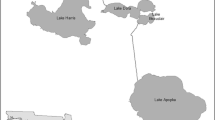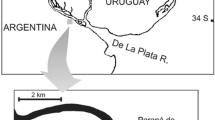Abstract
Hyperscums are crusted buoyant mats of densely packed cyanobacteria, often decimeters thick, that persist for periods of weeks to months at the same site. In Hartbeespoort Dam, a hypertrophic lake in South Africa, hyperscums of the cyanobacterium Microcystis aeruginosa that cover more than a hectare and contain up to 2 tons of chlorophyll a typically form in winter and persist for 2–3 months. This paper reports on the environmental conditions that favour hyperscum formation.
Reynolds & Walsby (1975) postulated that cyanobacterial bloom formation depended on the coincidence of three preconditions: a pre-existing population, a significant proportion of the organisms having positive buoyancy, and turbulent mixing that is too weak to overcome the tendency of the cells to float. This model of bloom formation is evaluated in the context of hyperscums, based on a case-study from Hartbeespoort Dam. We examine the occurrence of hyperscums and the dynamics of their formation and breakdown in relation to diurnal and seasonal changes in the wind regime and in relation to the population dynamics and buoyancy of Microcystis. We conclude that Reynolds and Walsby's preconditions are essential but not sufficient to explain hyperscum formation. The additional preconditions are prolonged low speed wind regime, suitable lake morphometry, large cyanobacterial standing crops, and high insolation. The rare co-occurrence of these conditions make hyperscums an uncommon phenomenon, but with increasing eutrophication worldwide the frequency and distribution of hyperscum occurrence are likely to increase.
Similar content being viewed by others
References
Abeliovich, A. & M. Shilo, 1972. Photooxidative death in blue-green algae. J. Bact. 111: 682–689.
Ashton, P. J., 1985. Nitrogen transformations and the nitrogen budget of a hypertrophic impoundment (Hartbeespoort Dam, South Africa). J. Limnol. Soc. sth. Afr. 11: 32–42.
Berg, K., W. W. Carmichael, O. M. Skulberg, C. Benestad & B. Underdal, 1987. Investigation of a toxic water-bloom of Microcystis aeruginosa (Cyanophyceae) in Lake Akersvatn, Norway. Hydrobiologia 144: 97–103.
Brock, T. D., 1985. A Eutrophic Lake: Lake Mendota, Wisconsin. Springer-Verlag, New York, 308 p.
Eloff, J. N., Y. Steinitz & M. Shilo, 1976. Photooxidation of cyanobacteria in natural conditions. Appl. environ. Microbiol. 31: 119–126.
Ganf, G. G., 1974. Diurnal mixing and the vertical distribution of phytoplankton in a shallow equatorial lake (Lake George, Uganda). J. Ecol. 62: 611–629.
George, D. G. & R. W. Edwards. 1976. The effect of wind on the distribution of chlorophyll a and crustacean plankton in a shallow eutrophic reservoir. J. appl. Ecol. 13: 667–690.
Harris, G. P., 1980. The measurement of photosynthesis in natural populations of phytoplantkon. In I. Morris (ed), Physiological Ecology of Phytoplankton, pp. 129–187. Blackwell, Oxford.
Hoppe, H. G., K. Gocke, D. Zamorano & R. Zimmermann, 1983. Degradation of macromolecular organic compounds in a tropical lagoon (Ciénaga Grande, Colombia) and its ecological significance. Int. Revue ges. Hydrobiol. 68: 811–824.
Kappers, F. I., 1984. On population dynamics of the cyanobacterium Microcystis aeruginosa. Ph.D. thesis, University of Amsterdam.
Krogmann, D. W., R. Butalla & J. Sprinkle, 1986. Blooms of cyanobacteria on the Potomac River. Pl. Physiol. 80: 667–671.
Kromkamp, J. C. & L. R. Mur, 1984. Buoyant density changes in the cyanobacterium Microcystis aeruginosa due to changes in the cellular carbohydrate content. FEMS Microbiol. Lett. 25: 105–109.
Krüger, G. H. J. & J. N. Eloff, 1978. The effect of temperature on specific growth rate and activation energy of Microcystis and Synechococcus isolates relevant to the onset of natural blooms. J. Limnol. Soc. sth. Aft. 4: 9–20.
Lehmann, H. & M. Jost, 1971. Kinetics of the assembly of gas vacuoles in the blue-green alga Microcystis aeruginosa Kuetz. emend. Elenkin. Arch. Mikrobiol. 79: 59–68.
Meijer, M. L. & H. van der Honing, 1986. Drijflagen van blauwalgen in het Brielse Meer. H2O 19(5): 90–94.
Nicklisch, A. & J. G. Kohl, 1983. Growth kinetics of Microcystis aeruginosa (Kutz) Kutz as a basis for modelling its population dynamics. Int. Revue ges. Hydrobiol. 68: 317–326.
Nusch, E. A., 1980. Comparison of different methods for chlorophyll and phaeopigment determination. Arch. Hydrobiol. 14: 14–36.
Paerl, H. W., J. Tucker & P. T. Bland, 1983. Carotenoid enhancement and its role in maintaining blue-green algal (Microcystis aeruginosa) surface blooms. Limnol. Oceanogr. 28: 847–857.
Paerl, H. W., P. T. Bland, N. D. Bowles & M. E. Harbach, 1985. Adaption of high-intensity, low-wavelength light among surface blooms of the cyanobacterium Microcystis aeruginosa. Appl. envir. Microbiol. 49: 1046–1052.
Raps, S., K. Wyman, H. W. Siegelman & P. G. Falkowski, 1983. Adaptation of the cyanobacterium Microcystis aeruginosa to light intensity. Pl. Physiol. 72: 829–832.
Reynolds, C. S., 1972. Growth, gas-vacuolation and buoyancy in a natural population of a blue-green alga. Freshwat. Biol. 2: 87–106.
Reynolds, C. S., 1984. The ecology of freshwater phytoplankton. Cambridge: Cambridge University Press, 384 pp.
Reynolds, C. S., 1987. Cyanobacterial water-blooms. In J. Callow (ed), Advances in Botanical Research, Academic Press, London 13: 67–143.
Reynolds, C. S. & A. E. Walsby, 1975. Water-blooms. Biol. Rev. 50: 437–481.
Reynolds, C. S., G. R. M. Jaworski, H. A. Cmiech & G. F. Leedale, 1981. On the annual cycle of the blue-green alga Microcystis aeruginosa Kütz. emend. Elenkin. Phil. Trans. r. Soc. Lond. B 293: 419–477.
Robarts, R. D., 1984. Factors controlling primary production in a hypertrophic lake (Hartbeespoort Dam, South Africa). J. Plankton Res. 6: 91–105.
Robarts, R. D., 1985. Hypertrophy, a consequence of development. Int. J. envir. Stud. 25: 167–175.
Robarts, R. D. & T. Zohary, 1984, Microcystis aeruginosa and underwater light attenuation in a hypertrophic lake (Hartbeespoort Dam, South Africa). J. Ecol. 72: 1001–1017.
Robarts, R. D. & T. Zohary, 1986. The influence of a cyanobacterial hyperscum on the heteroptrophic activity of planktonic bacteria in a hypertrophic lake. Appl. envir. Microbiol. 51: 609–613.
Robarts, R. D. & T. Zohary, 1987. Temperature effects on photosynthetic capacity, respiration and growth rate of bloom-forming cyanobacteria. N.Z. J. mar. Freshwat. Res. 21: 391–399.
Sachs, P., 1972. Wind forces in engineering. Pergamon Press, Oxford.
Scott, J. T., G. E. Myer, R. Stewart & E. G. Walther, 1969. On the mechanism of Langmuir circulations and their role in epilimnion mixing. Limnol. Oceanogr. 14: 493–503.
Seki, H., M. Takahashi, Y. Hara & S. Ichimura, 1980. Dynamics of dissolved oxygen during algal bloom in Lake Kasumigaura, Japan. Wat. Res. 14: 179–183.
Smith, R. V. & A. Peat, 1967. Comparative structure of the gas vacuoles of blue-green algae. Arch. Mikrobiol. 57: 111–122.
Thomas, R. H. & A. E. Walsby, 1985. Buoyancy regulation in a strain of Microcystis. J. gen. Microbiol. 131: 799–809.
Thomas, R. H. & A. E. Walsby, 1986. The effect of temperature on recovery of buoyancy by Microcystis. J. gen. Microbiol. 132: 1665–1672.
Topachevskiy, A. V., L. P. Braginskiy & L. A. Sirenko, 1969. Massive development of blue-green algae as a product of the ecosystem of a reservoir. Hydrobiol. J. 5(6): 1–10.
van Rijn, J. & M. Shilo, 1985. Carbohydrate fluctuations, gas vacuolation and vertical migration of scum-forming cyanobacteria in fishponds. Limnol. Oceanogr. 30: 1219–1228.
Yamagishi, H. & K. Aoyama, 1972. Ecological studies on dissolved oxygen and bloom of Microcystis in Lake Suwa — I. Horizontal distribution of dissolved oxygen in relation to drifting of Microcystis by wind. Bull. Jap. Soc. Sci. Fish. 38: 9–16.
Zohary, T., 1985. Hyperscums of the cyanobacterium Microcystis aeruginosa in a hypertrophic lake (Hartbeespoort Dam, South Africa). J. Plankton Res. 7: 399–409.
Zohary, T. & P. J. Ashton, 1985. The effects of design and operation on the efficiency of hosepipes as water column samplers for phytoplankton. J. Limnol Soc. sth. Afr. 11: 5–10.
Zohary, T. & R. D. Robarts, 1988. Diurnal mixed layers and the long-term dominance of Microcystis aeruginosa. J. Plankton Res. (in press).
Author information
Authors and Affiliations
Rights and permissions
About this article
Cite this article
Zohary, T., Breen, C.M. Environmental factors favouring the formation of Microcystis aeruginosa hyperscums in a hypertrophic lake. Hydrobiologia 178, 179–192 (1989). https://doi.org/10.1007/BF00006025
Received:
Revised:
Accepted:
Issue Date:
DOI: https://doi.org/10.1007/BF00006025




